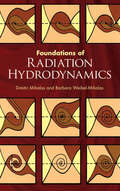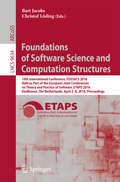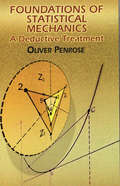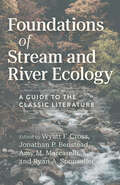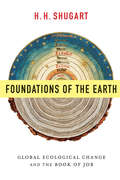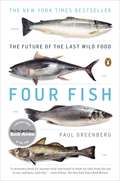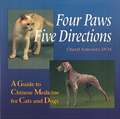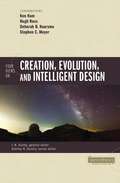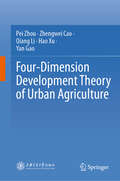- Table View
- List View
Foundations of Radiation Hydrodynamics
by Barbara Weibel Mihalas Dimitri MihalasRadiation hydrodynamics is a broad subject that cuts across many disciplines in physics and astronomy: fluid dynamics, thermodynamics, statistical mechanics, kinetic theory, and radiative transfer, among others. The theory developed in this book by two specialists in the field can be applied to the study of such diverse astrophysical phenomena as stellar winds, supernova explosions, and the initial phases of cosmic expansion, as well as the physics of laser fusion and reentry vehicles. As such, it provides students with the basic tools for research on radiating flows.Largely self-contained, the volume is divided into three parts: Chapters 1 to 5 focus on the dynamics of nonradiating fluids and then consider applications of a few astrophysically interesting problems concerning waves, shocks, and stellar winds. The second part of the book -- Chapters 5 to 8 -- deals with the physics of radiation, radiation transport, and the dynamics of radiating fluids, emphasizing the close relationship of radiation hydrodynamics to ordinary fluid dynamics. Part 3 comprises a short appendix on tensor calculus, explaining the use of tensor concepts in writing equations that allow a simple transition from ordinary fluids to relativistic fluids to radiation.Combining relevant material scattered widely among a large number of books, journal papers, and technical reports, this volume will be of immense value to students and researchers in many fields. 1984 edition.
Foundations of Restoration Ecology (The Science and Practice of Ecological Restoration Series)
by Donald A. Falk Joy B. Zedler Karen Holl Margaret A. PalmerThe practice of ecological restoration, firmly grounded in the science of restoration ecology, provides governments, organizations, and landowners a means to halt degradation and restore function and resilience to ecosystems stressed by climate change and other pressures on the natural world. Foundational theory is a critical component of the underlying science, providing valuable insights into restoring ecological systems effectively and understanding why some efforts to restore systems can fail. In turn, on-the-ground restoration projects can help to guide and refine theory, advancing the field and providing new ideas and innovations for practical application.This new edition of Foundations of Restoration Ecology provides the latest emerging theories and ideas in the science of restoration ecology. Fully one-third longer than the first edition and comprehensive in scope, it has been dramatically updated to reflect new research. Included are new sections devoted to concepts critical to all restoration projects as well as restoration of specific ecosystem processes, including hydrology, nutrient dynamics, and carbon. Also new to this edition are case studies that describe real-life restoration scenarios in North and South America, Europe, and Australia. They highlight supporting theory for restoration application and other details important for assessing the degree of success of restoration projects in a variety of contexts. Lists at the end of each chapter summarize new theory introduced in that chapter and its practical application.Written by acclaimed researchers in the field, this book provides practitioners as well as graduate and undergraduate students with a solid grounding in the newest advances in ecological science and theory.
Foundations of Signal Processing
by M. Vetterli J. Kova Evi V. K. GoyalThis comprehensive and engaging textbook introduces the basic principles and techniques of signal processing, from the fundamental ideas of signals and systems theory to real-world applications. Students are introduced to the powerful foundations of modern signal processing, including the basic geometry of Hilbert space, the mathematics of Fourier transforms, and essentials of sampling, interpolation, approximation and compression The authors discuss real-world issues and hurdles to using these tools, and ways of adapting them to overcome problems of finiteness and localization, the limitations of uncertainty, and computational costs. It includes over 160 homework problems and over 220 worked examples, specifically designed to test and expand students' understanding of the fundamentals of signal processing, and is accompanied by extensive online materials designed to aid learning, including Mathematica® resources and interactive demonstrations.
Foundations of Software Science and Computation Structures
by Bart Jacobs Christof LödingThis book constitutes the proceedings of the 19thInternational Conference on Foundations of Software Science and ComputationStructures, FOSSACS 2016, which took place in Eindhoven, The Netherlands, inApril 2016, held as Part of the European Joint Conferences on Theory andPractice of Software, ETAPS 2016. The 31 full papers presented in this volume werecarefully reviewed and selected from 85 submissions. They were organized intopical sections named: types; recursion and fixed-points; verification andprogram analysis; automata, logic, games; probabilistic and timed systems;proof theory and lambda calculus; algorithms for infinite systems; and monads.
Foundations of Solid State Physics: Dimensionality and Symmetry
by David Carroll Siegmar RothAn essential guide to solid state physics through the lens of dimensionality and symmetry Foundations of Solid State Physics introduces the essential topics of solid state physics as taught globally with a focus on understanding the properties of solids from the viewpoint of dimensionality and symmetry. Written in a conversational manner and designed to be accessible, the book contains a minimal amount of mathematics. The authors?noted experts on the topic?offer an insightful review of the basic topics, such as the static and dynamic lattice in real space, the reciprocal lattice, electrons in solids, and transport in materials and devices. The book also includes more advanced topics: the quasi-particle concept (phonons, solitons, polarons, excitons), strong electron-electron correlation, light-matter interactions, and spin systems. The authors' approach makes it possible to gain a clear understanding of conducting polymers, carbon nanotubes, nanowires, two-dimensional chalcogenides, perovskites and organic crystals in terms of their expressed dimension, topological connectedness, and quantum confinement. This important guide: -Offers an understanding of a variety of technology-relevant solid-state materials in terms of their dimension, topology and quantum confinement -Contains end-of-chapter problems with different degrees of difficulty to enhance understanding -Treats all classical topics of solid state physics courses - plus the physics of low-dimensional systems Written for students in physics, material sciences, and chemistry, lecturers, and other academics, Foundations of Solid State Physics explores the basic and advanced topics of solid state physics with a unique focus on dimensionality and symmetry.
Foundations of Statistical Mechanics: A Deductive Treatment
by Oliver PenroseThis volume demonstrates the manner in which statistical mechanics can be built up deductively from a small number of well-defined physical assumptions. A solid basis for the deductive structure is provided by embodying these assumptions in a system of five postulates that describe an idealized model of real physical systems. These postulates play a theoretical role similar to that of the first and second laws in thermodynamics.The first chapter concerns the primary physical assumptions and their idealization in the form of postulates. The following three chapters examine the consequences of these postulates, culminating in the derivation of the fundamental formulas for calculating probabilities in terms of dynamical quantities. Two concluding chapters are devoted to an analysis of the notion of entropy, illustrating its links between statistical mechanics and thermodynamics and between statistical mechanics and communication theory. Because this book deals mostly with general principles, its only detailed considerations of physical applications are in terms of the system with the simplest possible dynamics: the ideal classical gas, which is discussed both in its equilibrium and its nonequilibrium aspects.Intended for readers with a knowledge of physics at the advanced undergraduate and graduate levels, this volume considers topics of interest not only to physicists, but also to statisticians, communication theorists, chemists, and mathematicians.
Foundations of Stream and River Ecology: A Guide to the Classic Literature
by Nancy B. GrimmFor students and practitioners, a comprehensive primer on the key literature in stream and river ecology. The study of streams and rivers combines ecology, chemistry, hydrology, and geology to reveal the factors that control the biological diversity and functioning of these unique ecosystems. Although stream ecology is a relatively young discipline, foundational papers published over the past half century have shaped our current understanding of these ecosystems and have informed our efforts to manage and protect them. Organized by topics such as the physical template, community structure, food webs, ecosystem energetics, and nutrient dynamics, the chapters of this book offer summaries of the key literature, historical and contextual information, and insightful discussions of how past research has influenced present studies and may shape future work.
Foundations of a Sustainable Market Economy: Guiding Principles for Change
by Gjalt de Jong Margreet Boersma-de JongThe free market underpins our economy and our way of thinking around enterprise and value, but it is also a major factor in the sustainability problems that we now live with. Climate change, child labour and oil spills are just a few of the many problems associated with our economic activity and, although many companies have made an effort to produce more sustainably, the pace of change is much too slow. This engaging and accessible textbook teaches students the relationship between the economy and sustainability, assessing the hand of the free market on company behaviour and, ultimately, providing a framework for transition to a sustainable economy.Using case studies and optional assessment questions, this textbook explains to students what a market is at the macro level and then translates the effects of the market to industries and subsequently to the strategic choices of companies at the micro level. It adopts a model of 8 guiding principles that underpin the current free market economy and 8 guiding principles for the sustainable market economy. Switching these deeply held principles will be essential to any serious transition to a sustainable economy.
Foundations of the Earth
by H. H. Shugart"Where were you when I laid the foundation of the earth?" God asks Job in the "Whirlwind Speech," but Job cannot reply. This passage -- which some environmentalists and religious scholars treat as a "green" creation myth -- drives H. H. Shugart's extraordinary investigation, in which he uses verses from God's speech to Job to explore the planetary system, animal domestication, sea-level rise, evolution, biodiversity, weather phenomena, and climate change.Shugart calls attention to the rich resonance between the Earth's natural history and the workings of religious feeling, the wisdom of Bible scripture, and the arguments of Bible ethicists. The divine questions that frame his study are quintessentially religious, and the global changes humans have wrought on the Earth operate in not only the physical, chemical, and biological spheres but also the spiritual realm. Shugart offers a universal framework for recognizing and confronting the global challenges humans now face: the relationship between human technology and large-scale environmental degradation; the effect of invasive species on the integrity of ecosystems; the role of humans in generating wide biotic extinctions; and the future functioning of our oceans and tides.
Foundations of the Earth
by H. H. Shugart"Where were you when I laid the foundation of the earth?" God asks Job in the "Whirlwind Speech," but Job cannot reply. This passage -- which some environmentalists and religious scholars treat as a "green" creation myth -- drives H. H. Shugart's extraordinary investigation, in which he uses verses from God's speech to Job to explore the planetary system, animal domestication, sea-level rise, evolution, biodiversity, weather phenomena, and climate change.Shugart calls attention to the rich resonance between the Earth's natural history and the workings of religious feeling, the wisdom of Bible scripture, and the arguments of Bible ethicists. The divine questions that frame his study are quintessentially religious, and the global changes humans have wrought on the Earth operate in not only the physical, chemical, and biological spheres but also the spiritual realm. Shugart offers a universal framework for recognizing and confronting the global challenges humans now face: the relationship between human technology and large-scale environmental degradation; the effect of invasive species on the integrity of ecosystems; the role of humans in generating wide biotic extinctions; and the future functioning of our oceans and tides.
Foundations of the Earth
by H. H. Shugart"Where were you when I laid the foundation of the earth?" God asks Job in the "Whirlwind Speech," but Job cannot reply. This passage -- which some environmentalists and religious scholars treat as a "green" creation myth -- drives H. H. Shugart's extraordinary investigation, in which he uses verses from God's speech to Job to explore the planetary system, animal domestication, sea-level rise, evolution, biodiversity, weather phenomena, and climate change.Shugart calls attention to the rich resonance between the Earth's natural history and the workings of religious feeling, the wisdom of Bible scripture, and the arguments of Bible ethicists. The divine questions that frame his study are quintessentially religious, and the global changes humans have wrought on the Earth operate in not only the physical, chemical, and biological spheres but also the spiritual realm. Shugart offers a universal framework for recognizing and confronting the global challenges humans now face: the relationship between human technology and large-scale environmental degradation; the effect of invasive species on the integrity of ecosystems; the role of humans in generating wide biotic extinctions; and the future functioning of our oceans and tides.
Foundations of the Earth: Global Ecological Change and the Book of Job
by H.H. Shugart"Where were you when I laid the foundation of the earth?" God asks Job in the "Whirlwind Speech," but Job cannot reply. This passage—which some environmentalists and religious scholars treat as a "green" creation myth—drives renowned ecologist H. H. Shugart's extraordinary investigation, in which he uses verses from God's speech to Job to explore the planetary system, animal domestication, sea-level rise, evolution, biodiversity, weather phenomena, and climate change. Shugart calls attention to the rich resonance between the Earth's natural history and the workings of religious feeling, the wisdom of biblical scripture, and the arguments of Bible ethicists. The divine questions that frame his study are quintessentially religious, and the global changes humans have wrought on the Earth operate not only in the physical, chemical, and biological spheres but also in the spiritual realm. Shugart offers a universal framework for recognizing and confronting the global challenges humans now face: the relationship between human technology and large-scale environmental degradation, the effect of invasive species on the integrity of ecosystems, the role of humans in generating wide biotic extinctions, and the future of our oceans and tides.
Founders of the Future: The Science and Industry of Spanish Modernization (Campos Ibéricos: Bucknell Studies in Iberian Literatures and Cultures)
by Óscar Iván UsecheIn this ambitious new interdisciplinary study, Useche proposes the metaphor of the social foundry to parse how industrialization informed and shaped cultural and national discourses in late nineteenth- and early twentieth-century Spain. Across a variety of texts, Spanish writers, scientists, educators, and politicians appropriated the new economies of industrial production—particularly its emphasis on the human capacity to transform reality through energy and work—to produce new conceptual frameworks that changed their vision of the future. These influences soon appeared in plans to enhance the nation’s productivity, justify systems of class stratification and labor exploitation, or suggest state organizational improvements. This fresh look at canonical writers such as Emilia Pardo Bazán, Concha Espina, Benito Pérez Galdós, Vicente Blasco Ibáñez, and José Echegaray as well as lesser known authors offers close readings of their work as it reflected the complexity of Spain’s process of modernization.
Four Centuries of Clinical Chemistry
by Louis RosenfeldThe origin and early years of any rapidly changing scientific discipline runs the risk of being forgotten unless a record of its past is preserved. In this, the first book-length history of clinical chemistry, those involved or interested in the field will read about who and what went before them and how the profession came to its present state of clinical importance. The narrative reconstructs the origins of clinical chemistry in the seventeenth century and traces its often obscure path of development in the shadow of organic chemistry, physiology and biochemistry until it assumes its own identity at the beginning of the twentieth century. The chronological development of the story reveals the varied roots from which modern clinical chemistry arose.
Four Fish: The Future of the Last Wild Food
by Paul GreenbergOur relationship with the ocean is undergoing a profound transformation. Whereas just three decades ago nearly everything we ate from the sea was wild, rampant overfishing combined with an unprecedented bio-tech revolution has brought us to a point where wild and farmed fish occupy equal parts of a complex and confusing marketplace. We stand at the edge of a cataclysm; there is a distinct possibility that our children's children will never eat a wild fish that has swum freely in the sea. In Four Fish, award-winning writer and lifelong fisherman Paul Greenberg takes us on a culinary journey, exploring the history of the fish that dominate our menus---salmon, sea bass, cod and tuna-and examining where each stands at this critical moment in time. He visits Norwegian mega farms that use genetic techniques once pioneered on sheep to grow millions of pounds of salmon a year. He travels to the ancestral river of the Yupik Eskimos to see the only Fair Trade certified fishing company in the world. He investigates the way PCBs and mercury find their way into seafood; discovers how Mediterranean sea bass went global; Challenges the author of Cod to taste the difference between a farmed and a wild cod; and almost sinks to the bottom of the South Pacific while searching for an alternative to endangered bluefin tuna. Fish, Greenberg reveals, are the last truly wild food - for now. By examining the forces that get fish to our dinner tables, he shows how we can start to heal the oceans and fight for a world where healthy and sustainable seafood is the rule rather than the exception.
Four Keys to the Natural Anabolic State: The Pathway to Health, Fitness, Faith, and a Huge Competitive Edge
by William G. AlstonThis book reveals a stunning thread of scientific data that points the way to the natural anabolic state--a biochemical condition wherein body fat is metabolized, muscle tissue is built, strength and speed are increased, mental acuity is enhanced, and the
Four Paws Five Directions: A Guide to Chinese Medicine for Cats and Dogs
by Cheryl Schwartz"Veterinarians and all who want to learn about healing animals cannot be without this landmark book. Dr. Schwartz is to be congratulated for providing new dimensions to the art and science of veterinary medicine and for deriving new meaning from ancient wisdom for the benefit of all sentient beings" -Dr. Michael W. Fox
Four Pillars of Radio Astronomy: Mills, Christiansen, Wild, Bracewell (Astronomers' Universe)
by R. H. Frater W. M. Goss H. W. WendtThis is the story of Bernie Mills, Chris Christiansen, Paul Wild and Ron Bracewell, members of a team of radio astronomers that would lead Australia, and the world, into this new field of research. Each of the four is remembered for his remarkable work: Mills for the development the cross type instrument that now bears his name; Christiansen for the application of rotational synthesis techniques; Wild for the masterful joining of observations and theory to elicit the nature of the solar atmosphere; Bracewell for his contribution to imaging theory. As well, these Four Pillars are remembered for creating a remarkable environment for scientific discovery and for influencing the careers of future generations. Their pursuit of basic science helped pave the way for technological developments in areas ranging from Wi-Fi to sonar to medical imaging to air navigation, and for underpinning the foundations of modern cosmology and astrophysics.
Four Revolutions in the Earth Sciences
by James Lawrence PowellJames Lawrence Powell serves as executive director of the National Physical Science Consortium, a partnership among government agencies and laboratories, industry, and higher education dedicated to increasing the number of American citizens with graduate degrees in the physical sciences and related engineering fields, emphasizing recruitment of a diverse applicant pool that includes women and minorities. He received his Ph.D from the Massachusetts Institute of Technology and has taught at Oberlin College and served as its acting president. He has also been president of Franklin and Marshall College, Reed College, the Franklin Institute Science Museum in Philadelphia, and the Los Angeles County Museum of Natural History. Presidents Ronald Reagan and George H. W. Bush both appointed Powell to the National Science Board. He is also the author of The Inquisition of Climate Science.
Four Revolutions in the Earth Sciences: From Heresy to Truth
by James Lawrence PowellJames Lawrence Powell serves as executive director of the National Physical Science Consortium, a partnership among government agencies and laboratories, industry, and higher education dedicated to increasing the number of American citizens with graduate degrees in the physical sciences and related engineering fields, emphasizing recruitment of a diverse applicant pool that includes women and minorities. He received his Ph.D from the Massachusetts Institute of Technology and has taught at Oberlin College and served as its acting president. He has also been president of Franklin and Marshall College, Reed College, the Franklin Institute Science Museum in Philadelphia, and the Los Angeles County Museum of Natural History. Presidents Ronald Reagan and George H. W. Bush both appointed Powell to the National Science Board. He is also the author of The Inquisition of Climate Science.
Four Revolutions in the Earth Sciences: From Heresy to Truth
by James PowellOver the course of the twentieth century, scientists came to accept four counterintuitive yet fundamental facts about the Earth: deep time, continental drift, meteorite impact, and global warming. When first suggested, each proposition violated scientific orthodoxy and was quickly denounced as scientific—and sometimes religious—heresy. Nevertheless, after decades of rejection, scientists came to accept each theory. The stories behind these four discoveries reflect more than the fascinating push and pull of scientific work. They reveal the provocative nature of science and how it raises profound and sometimes uncomfortable truths as it advances. For example, counter to common sense, the Earth and the solar system are older than all of human existence; the interactions among the moving plates and the continents they carry account for nearly all of the Earth's surface features; and nearly every important feature of our solar system results from the chance collision of objects in space. Most surprising of all, we humans have altered the climate of an entire planet and now threaten the future of civilization. This absorbing scientific history is the only book to describe the evolution of these four ideas from heresy to truth, showing how science works in practice and how it inevitably corrects the mistakes of its practitioners. Scientists can be wrong, but they do not stay wrong. In the process, astonishing ideas are born, tested, and over time take root.
Four Treatises of Theophrastus Von Hohenheim Called Paracelsus
by ParacelsusFour treatises which illustrate one of the most original minds of the Renaissance at the height of his powers.Born near Einsiedeln in 1493, Philip Theophrastus von Hohenheim, who later called himself Paracelsus, was the son of a physician. His thirst for knowledge led him to study arts in Vienna, then medicine in Italy, but the instruction left him disillusioned. He had learned to see nature with his own eyes, undiluted by the teachings of books. He was a rebellious spirit, hard-headed and stubborn, who travelled all over Europe and the British Isles to practice medicine, study local diseases, and learn from any source he could, humble as it might be. In these years of wanderings, Paracelsus developed his own system of medicine and a philosophy of theology all his own. Though he wrote a great many books that covered a wide range of subjects, only a few of his works were ever published in his lifetime. When he died in Salzburg in 1541, one of the most forceful personalities of the Renaissance died with him. Here are collected four treatises which illustrate four different aspects of Paracelsus' work. The first gives a passionate justification of his character, activities, and views, and gives a picture of the man and his basic ideas. The second treatise is a study of the diseases of miners, with whom Paracelsus had spent a great deal of time. Then follows a treatise on the psychology and psychiatry of Paracelsus. Written at a time when mental diseases were beginning to be studied and treated by physicians, this pioneering essay anticipates a number of modern views. The last essay, entitled "A Book on Nymphs, Sylphs, Pygmies, and Salamanders, and on the Other Spirits," is a fanciful and poetic treatment of paganism and Greek mythology, as well as a good sample of Paracelsus' philosophy and theology. Together these essays show one of the most original minds of the Renaissance at the height of his powers.
Four Views on Creation, Evolution, and Intelligent Design
by Hugh Ross Stanley N. Gundry Stephen C. Meyer Ken Ham J. B. Stump Deborah HaarsmaFour Views on Creation, Evolution, and Intelligent Design presents the current "state of the conversation" about origins among evangelicals representing four key positions:Young Earth Creationism - Ken Ham (Answers in Genesis)Old Earth (Progressive) Creationism - Hugh Ross (Reasons to Believe)Evolutionary Creation - Deborah B. Haarsma (BioLogos)Intelligent Design - Stephen C. Meyer (The Discovery Institute)The contributors offer their best defense of their position addressing questions such as: What is your position on origins - understood broadly to include the physical universe, life, and human beings in particular? What do you take to be the most persuasive arguments in defense of your position? How do you demarcate and correlate evidence about origins from current science and from divine revelation? What hinges on answering these questions correctly?
Four Views on the Historical Adam (Counterpoints: Bible and Theology)
by Gregory A. Boyd Stanley N. Gundry John H. Walton Ardel Caneday C. John Collins Denis Lamoureux Matthew Barrett Philip G. Ryken William D. BarrickAs a part of the Counterpoints series, Four Views on the Historical Adam clearly outlines four primary views on Adam held by evangelicals, featuring top-notch proponents of each view presenting their positions in their own words and critiquing the positions with which they disagree. You will come away with a better understanding of the key biblical and theological issues at stake and of the implications of Adam for contemporary Christian witness and church life. Contributors include Denis O. Lamoureux, John H. Walton, C. John Collins, and William Barrick. Each focuses his essay on answering the following questions: What is the biblical case for your viewpoint, and how do you reconcile it both with modern science and with passages and potential interpretations that seem to counter it? In what ways is your view more theologically consistent and coherent than other views? What are the implications of your view for the spiritual life and public witness of the church and individual believers, and how is your view a healthier alternative for both? Concluding reflections by pastor-scholars Gregory A. Boyd and Philip Graham Ryken highlight the significance of the topic in the faith of everyday believers.
Four-Dimension Development Theory of Urban Agriculture
by Qiang Li Hao Xu Yan Gao Pei Zhou Zhengwei CaoThis book provides a detailed study of urban agricultural development. It establishes a comprehensive evaluation system for urban agriculture and accurately grasps the development level and status of urban agriculture, to provide action guidelines for decision-making bodies in urban agriculture. This book is intended for graduate students who are interested in the development of urban agriculture and researchers studying the field of urban agriculture.
